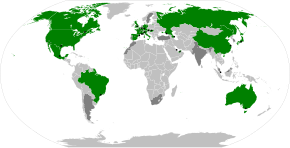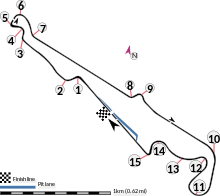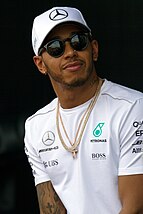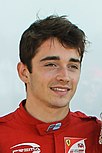A | B | C | D | E | F | G | H | CH | I | J | K | L | M | N | O | P | Q | R | S | T | U | V | W | X | Y | Z | 0 | 1 | 2 | 3 | 4 | 5 | 6 | 7 | 8 | 9
The 2018 FIA Formula One World Championship was the motor racing championship for Formula One cars and the 69th running of the Formula One World Championship. Formula One is recognised by the governing body of international motorsport, the Fédération Internationale de l'Automobile (FIA), as the highest class of competition for open-wheel racing cars. Drivers and teams competed in twenty-one Grands Prix for the World Drivers' and World Constructors' championship titles.
For the second consecutive year, the season featured a title battle between Mercedes and Ferrari. The 2018 season saw two four-time World Champions, Lewis Hamilton and Sebastian Vettel, as the main Championship challengers. It was the first time in Formula One history, two quadruple world champions would be competing for a fifth title and the season was billed as the Fight for Five by journalists and fans.[1][2][3] The championship lead ebbed and flowed between the two title contenders, the points lead swapping hands five times throughout the year. At the halfway point after the British Grand Prix, Vettel led the title battle by eight points. Hamilton clinched his fifth World Drivers' Championship title at the 2018 Mexican Grand Prix, with the team securing its fifth consecutive World Constructors' Championship title at the following race.[4][5][6] Ferrari driver Sebastian Vettel finished runner-up, 88 points behind Hamilton, with his teammate Kimi Räikkönen finishing third. In the Constructors' Championship, Mercedes finished 84 points ahead of Ferrari, with Red Bull Racing-TAG Heuer in third, 152 points behind Ferrari.[7]
In 2018, the championship saw the introduction of a new cockpit protection device, known as the "halo". The introduction of the halo was the first stage of a planned rollout that would see the device adopted in all FIA-sanctioned open wheel series by 2020.
Entries
The following teams and drivers participated in the 2018 FIA Formula One World Championship. All teams competed with tyres supplied by Pirelli.
† All engines were 1.6 litre, V6 turbo hybrid configuration.
- ^ Scuderia Ferrari entered as "Scuderia Ferrari Mission Winnow" for the final five championship rounds.
- ^ Sahara Force India F1 Team was excluded from the championship when its parent company went into administration and the team was unable to continue after race 12 of the season. The team's assets were purchased by Racing Point UK Ltd. and entered into the championship as the new team known as Racing Point Force India F1 Team, which competed from race 13 (Belgian Grand Prix) onwards.[8]
- ^ Red Bull Racing used Renault R.E.18 power units. For sponsorship purposes, these engines were rebadged as "TAG Heuer".[9]
Free practice drivers
Across the season six drivers served as third or free practice drivers for teams. Lewis Hamilton ran the number one on his car in Abu Dhabi Grand Prix first practice.[13]
| Constructor | No. | Driver name | Rounds |
|---|---|---|---|
| Force India-Mercedes | 34 | 7, 111 16, 18–202 | |
| McLaren-Renault | 47 | 13–14, 16–20 | |
| Renault | 46 | 16 | |
| Sauber-Ferrari | 36 | 11–12, 16, 19–21 | |
| Scuderia Toro Rosso-Honda | 38 | 18 | |
| Williams-Mercedes | 40 | 5, 9, 21 | |
| Source:[12] | |||
^1 – Contested under Sahara Force India ownership.
^2 – Contested under Racing Point Force India ownership.
Team changes
McLaren terminated their engine partnership with Honda and instead signed a three-year deal for power units supplied by Renault.[14] The team cited Honda's repeated failure to supply a reliable and competitive power unit as the reason for ending the partnership.[14]
Toro Rosso parted ways with Renault – allowing McLaren to finalise their agreement with Renault – and came to an agreement to use full-works Honda power units for the first time in history.[15] As part of the deal, Red Bull Racing loaned Toro Rosso driver Carlos Sainz Jr. to Renault's works team.[16][17]
Sauber renewed their partnership with Ferrari, upgrading to current-specification power units after using year-old power units in 2017 and also signed a sponsorship deal that saw Alfa Romeo become their title sponsor.[18][19]
Mid-season changes
Force India were placed into administration on 27 July 2018, during the Hungarian Grand Prix weekend.[20] After speculation of a purchase,[21] any sale of the team in a short time-span was complicated by legal proceedings against certain shareholders and the need for debt settlement.[22] A consortium led by Lawrence Stroll purchased the racing assets and operations of Force India through a company named Racing Point UK Ltd.[23] The original team, known as "Sahara Force India", was then excluded from the Constructors' Championship on the grounds of their inability to participate in remaining races. This allowed a new team known as "Racing Point Force India" to apply for a late entry and start their participation in the championship from the Belgian Grand Prix.[8][24] The team was required to keep "Force India" as part of their constructor name as their chassis had been homologated under the Force India name and Formula One sporting regulations required the constructor name to include the chassis name.[25][22] The new team began with zero points in the Constructors' Championship, though their drivers retained the points they had scored in the Drivers' Championship.[24] The other teams later agreed to allow the Racing Point Force India team to retain prize money accrued by Sahara Force India in the preceding years.[26][22]
Driver changes
- Toro Rosso signed 2016 GP2 Series champion Pierre Gasly and two-time World Endurance champion Brendon Hartley as their full-time drivers for 2018, with Hartley becoming the first full-time New Zealander driver since Denny Hulme in 1974.[27] Both Gasly and Hartley made their Formula One debuts with the team in the latter stages of the 2017 championship.[27] Daniil Kvyat left the team and the Red Bull driver programme, securing a development role with Ferrari.[28]
- Charles Leclerc, the reigning Formula 2 champion, made his competitive début with Sauber.[29] Leclerc, who had previously driven in Friday practice sessions in 2016 and 2017, was hired by the team to replace Pascal Wehrlein.[29] Wehrlein was ultimately unable to secure a race seat and was instead enlisted as one of Mercedes's test and reserve drivers while racing full-time in the Deutsche Tourenwagen Masters series.[30][31][32]
- 2008 runner-up Felipe Massa retired from Formula One at the end of the 2017 championship.[33] Massa was replaced by former Renault test driver and SMP Racing driver Sergey Sirotkin, who made his competitive début with the team.[34]
Calendar

The following twenty-one Grands Prix were run as part of the 2018 World Championship:
Calendar changes

The French Grand Prix returned to the calendar for the first time since 2008. The race has returned to the Circuit Paul Ricard, which last hosted the French Grand Prix in 1990 before the event moved to the Circuit de Nevers Magny-Cours.[36][a] The race was scheduled to be run in June, with the Azerbaijan Grand Prix brought forward to April to accommodate the change and to avoid clashing with celebrations for the centenary of the Azerbaijan republic.[37] The German Grand Prix also returned to the championship after a one-year absence, with the Hockenheimring hosting the race.[38]
The Malaysian Grand Prix, which was part of the championship from 1999 to 2017, was discontinued.[39] The Russian Grand Prix was moved from April to September, filling the vacancy left by the Malaysian Grand Prix.[40]
Changes
Sporting regulations
Following widespread criticism of the grid penalty system in 2017 that regularly saw multiple drivers start races outside their qualifying positions, the FIA introduced a revised set of regulations for 2018. In the event that a driver changes a power unit component, they are still subject to a five- or ten-place grid penalty depending on the component being changed; however, should they then replace a second component, they will be moved to the back of the starting grid.[41] If multiple drivers are moved to the back of the grid, their starting positions are determined by the order that components were changed based on the most recent change made by each driver.[41]
The rules governing starting procedures were changed for 2018, granting race stewards the power to issue penalties for improper race starts even if a driver's start does not trigger the automated detection system.[42] The changes were introduced following two incidents during 2017: at the Chinese Grand Prix, Sebastian Vettel positioned his car too far across his grid slot to be registered by the detection system; while at the Austrian Grand Prix, Valtteri Bottas's start was called into question for his reaction time despite the detection system recognising it as legal.[42]
In the event that a race is suspended due to a red flag, it would be restarted with a standing start. Drivers would return to the starting grid in the positions they held at the time of the suspension and the race director would repeat the race start procedure. If circuit conditions are suitable for racing but the race director deems a standing start inappropriate, the race would resume with a rolling start where the safety car returns to pit lane and drivers proceed around the circuit in single file until they are shown the green flag.[43]
The FIA introduced tighter restrictions on racing licences issued to drivers taking part in free practice sessions. Candidate drivers are required to complete a minimum number of Formula 2 races or earn twenty-five superlicense points over a three-year period. The changes were introduced to address concerns about drivers who would not be able to meet the standards required to compete in Formula One having access to Formula One cars.[44]
The schedule of a Grand Prix weekend was changed, with the start time of most European races pushed back by one hour in an attempt to accommodate a larger television audience. All races were scheduled to start at ten minutes past the hour so as to allow broadcasters the opportunity for pre-race coverage, especially in cases when their broadcast of the race starts on the hour.[45]
Finally, the mid-season test, which was held in Bahrain in 2017, was moved to Barcelona.[46][47]
Technical regulations
Power unit suppliers are required to provide all teams using their engines with an identical specification of power units. The change was introduced to ensure parity after Mercedes's works team was observed to have access to additional engine performance settings that were not available to their customer teams.[48]
The quantity of power unit components a driver may use during the season was reduced from four complete power units during the entire season in 2017 to a new system where each of the power unit components is considered separately.[49] Therefore, in 2018, each driver is permitted to use up to three each of internal combustion engines (ICE), heat motor generator units (MGU-H), and turbochargers (TC); and two each of the kinetic motor generator units (MGU-K), energy stores (ES), and control electronics (CE).[49]
Restrictions against the practice of oil burning, where engine oils are burned as fuel to boost performance, were also introduced. The practice, which was first used in 2017 saw teams burning as much as 1.2 litres per one hundred kilometres. For the 2018 championship, this figure was revised down to a maximum of 0.6 litres per one hundred kilometres.[50] The rules were further amended to restrict teams to using a single specification of oil, which must be declared before the race. These oils are subject to stricter definitions of what is considered "oil" in order to prevent teams from using exotic blends designed to boost performance. Teams are also required to inform the stewards of the mass of oil in each oil tank before the race.[51][b]
Further changes to the technical regulations require the temperature of air in the plenum chamber – adjacent to the turbocharger – to be more than 10 °C above the ambient air temperature. This rule was introduced in a bid to limit the performance gains possible via charge air cooling.[51] Active control valves, which electronically regulate the flow of fluids between power unit components, were also banned.[51]
The FIA banned the use of "shark fins", a carbon fibre extension to the engine cowling aimed at directing airflow over the rear wing.[52][53] The use of "T-wings", a horizontal secondary wing mounted forward of and above the rear wing, was also banned.[52]
Zdroj:https://en.wikipedia.org?pojem=2018_FIA_Formula_One_World_Championship>Text je dostupný pod licencí Creative Commons Uveďte autora – Zachovejte licenci, případně za dalších podmínek. Podrobnosti naleznete na stránce Podmínky užití.
Text je dostupný za podmienok Creative
Commons Attribution/Share-Alike License 3.0 Unported; prípadne za ďalších
podmienok.
Podrobnejšie informácie nájdete na stránke Podmienky
použitia.









